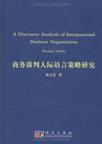商务谈判人际语言策略研究
1970-1
科学出版社
杨文慧
289
商务谈判是商务工作的一个重要环节,也是决定商务工作成败的关键。《商务谈判人际语言策略研究》从语篇分析的角度,在综合诸如社会语言学、语用学、语篇分析等学科的研究成果上,运用话语分析CA(conversation analvsis)的研究方法,探讨人际关系如何影响商务谈判的整体话语结构(global structure)、言语行为(speech act)、词形运用(1exical forms)以及它们与礼貌策略的内在关联,并对跨文化商务谈判中的文化语言现象做了一定的对比和分析。作者在前人研究的社会交际和礼貌策略理论基础上,以真实的商务谈判对话为研究语料,分析商务谈判的本质和语言运用,比如:人际关系策略、语言策略、礼貌策略等。该研究旨在从语言文化的层面识别和分析谈判会话的组建、完成、语言表象(比如:句式层面和词形层面语用的优先选择)以及它们在商务谈判中与人际关系和商务关系的内在关系。作者通过对谈判对话框架、语言和礼貌策略的分析,以大量的实证证明,“人际关系”作为一种文化要素,对谈判的话语模式、语言行为和礼貌策略起着至关重要的作用。在对中国贸易谈判实证调查的基础上,该项研究的发现为研究商务交际和人际关系提供了有力的佐证。研究指出,中国商务谈判者在不同的人际和商务关系下运用不同的谈判模式和语用策略来实现不同的谈判目的。随着人际和商务关系的发展,谈判者(1)在谈判结构的组建中越来越多地、有目的地使用与社交相关联的交际元件,并重复这些元件、延伸这些元件,甚至将这些元件与其他工作相关联的交际元件交叠;谈判的话语模式和元件的使用则越来越复杂和无规律性;(2)在言语行为方面(如请求语)越来越多地使用各种礼貌策略和面子观,言语行为策略更为多元化,谈判者倾向使用的礼貌策略和间接语并不一定是线性的或固有的;(3)在谈判的言语行为中越来越多地运用各种词形(如比喻的词形运用)来影响或构建礼貌策略。在很大程度上,商务谈判者以不同的社交身份和职业身份。
《商务谈判人际语言策略研究》从语篇分析的角度,在综合诸如社会语言学、语用学、语篇分析等学科的研究成果上,运用话语分析CA(conversation analvsis)的研究方法,探讨人际关系如何影响商务谈判的整体话语结构、言语行为、词形运用以及它们与礼貌策略的内在关联,并对跨文化商务谈判中的文化语言现象做了一定的对比和分析。作者在前人研究的社会交际和礼貌策略理论基础上,以真实的商务谈判对话为研究语料,分析商务谈判的本质和语言运用,比如:人际关系策略、语言策略、礼貌策略等。该研究旨在从语言文化的层面识别和分析谈判会话的组建、完成、语言表象(比如:句式层面和词形层面语用的优先选择)以及它们在商务谈判中与人际关系和商务关系的内在关系。作者通过对谈判对话框架、语言和礼貌策略的分析,以大量的实证证明,“人际关系”作为一种文化要素,对谈判的话语模式、语言行为和礼貌策略起着至关重要的作用。
ForewordAbstractChapter 1 Introduction1.1 The Social Background1.2 The Research Background1.3 Research Objectives1.4 The Rationale of the Study1.5 SummaryChapter 2 Literature Review and Descriptive Framework2.1 Relevant Research on Business Negotiations2.1.1 Definition of Negotiation2.1.2 Current Discourse Studies of Business Negotiations2.1.3 Current Studies of Interpersonal Communication2.2 Relevant Studies of Negotiation Structure and Patterns2.2.1 Prescriptive and Descriptive Models2.2.2 Social Conversational Structure and Speech Elements2.3 Negotiation Language and Culture2.3.1 Business Negotiation Language2.3.2 Politeness in Communication2.3.3 Chinese Business Contexts2.4 SummaryChapter 3 Research Scope and Methodology3.1 Introduction3.2 Research Scope3.3 Research Methodology3.3.1 The Data and Transcription Conventions3.3.2 Subject Selection and Recording Procedures3.3.3 Analysis Procedure3.4 The Division of Interpersonal Relationships in Business Negotiations3.5 SummaryChapter 4 The Structure of Interpersonal Business Negotiations4.1 Introduction4.2 The Global Structure of Business Negotiations4.2.1 Opening Stage4.2.2 Negotiating Stage4.2.3 Closing Stage4.3 The Conversational Structure of Business Negotiations4.4 The Impact of Interpersonal Relationship on Business Negotiations4.5 SummaryChapter 5 Requests and Politeness Strategies in Business Negotiations5.1 Introduction5.2 Requests and Politeness Strategy5.2.1 Requests and Politeness Strategies in Business Negotiations5.3 Generic Preference for Business Requests and Politeness Strategies5.3.1 General Distribution of Politeness Strategies in Business Requests5.3.2 Interpersonal Variation in Request Strategies and Politeness5.4 The Impact of Interpersonal Relationship on Business Requests and Interpersonal Politeness System5.5 SummaryChapter 6 Metaphors as Politeness Strategies in Business Negotiations6.1 Introduction6.2 Metaphors as Politeness Strategies6.2.1 FTAs6.2.2 Metaphors as Politeness Strategies in FTAs6.2.3 Linguistic Realizations of Metaphorical Expression in FTAs6.2.4 Distribution of Metaphors in Business Negotiations6.3 Negotiators' Generic Preferences for Metaphors in Business Negotiations6.3.1 Metaphors Used by the BS Group6.3.2 Metaphors Used by the BF Group6.3.3 Metaphors Used by the BP Group6.4 The Impact of Interpersonal Relationship on Metaphors in FTAs6.5 SummaryChapter 7 Conclusion7.1 Introduction7.2 Summary of the Key Findings7.3 A Cultural Perspective on Conversational Structure7.4 A Cultural Perspective on Request7.5 A Cultural Perspective on Metaphor7.6 A Cultural Perspective on Interpersonal Business Communication7.7 Significance7.8 Limitations7.9 SummaryReferences
插图:Business negotiations at the global level represent both opportu-nities and challenges to individuals and organizations.In order todevelop these opportunities,individuals and organizations need todevelop multiple cultural perspectives and approaches to conductingbusiness,and learning to communicate with international colleaguesas equals,rather than from a superior-inferior stance.As business ne-gotiators,"they must forge a transcultural vision that is not bound bynational definition.They must be able to clearly communicate thisvision to others.They also need to have the necessary communicationskills to translate this vision into practice in the diverse workplace"(Ting-Toomey 1999:4).In order to communicate effectively with peo-ple from other cultures,business negotiators need to learn the funda-mental concepts and skills of cross-cultural communication,and theirinterrelation with communication strategies and language issues. So far,the study of business negotiations is especially critical forat least four reasons at the micro level.Firstly,more and more compa-nies today,under the market-economic situation,have their own salesand marketing departments.The staff who work in these departmentsaccount for great entrants into the business line.As company nego-tiators,they need to improve their negotiation skills with the mostupdated knowledge and information about themselves and the nego-tiators from other cultures within the rapidly changing society.Sec-ondly,many universities in the world now have set up businessschools or offered business-related majors,whose graduates havebeen exposed to the knowledge of modern management and commu-nication styles to some extent.
《商务谈判人际语言策略研究》是由科学出版社出版的。

写论文的可以好好看看,可以学到不少东西